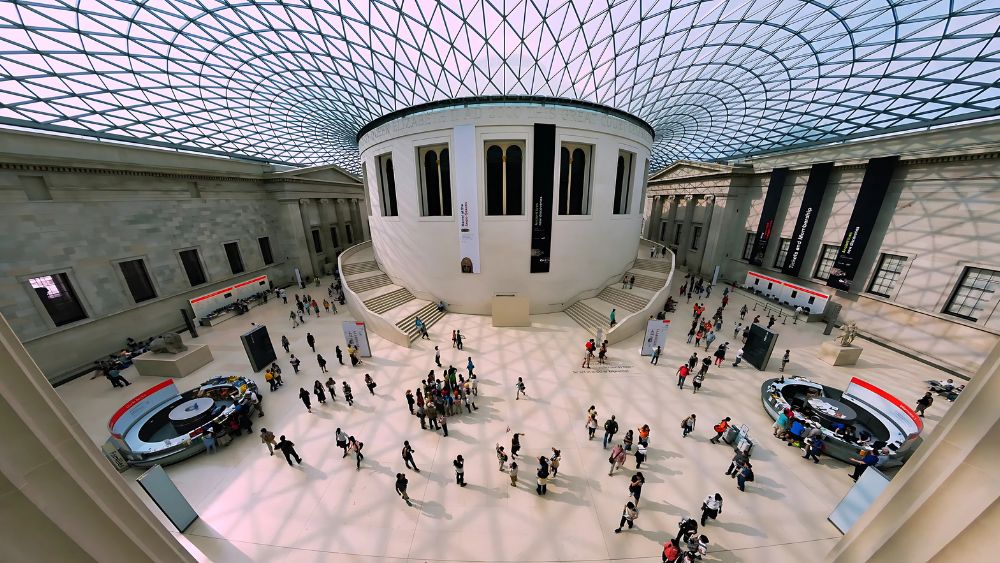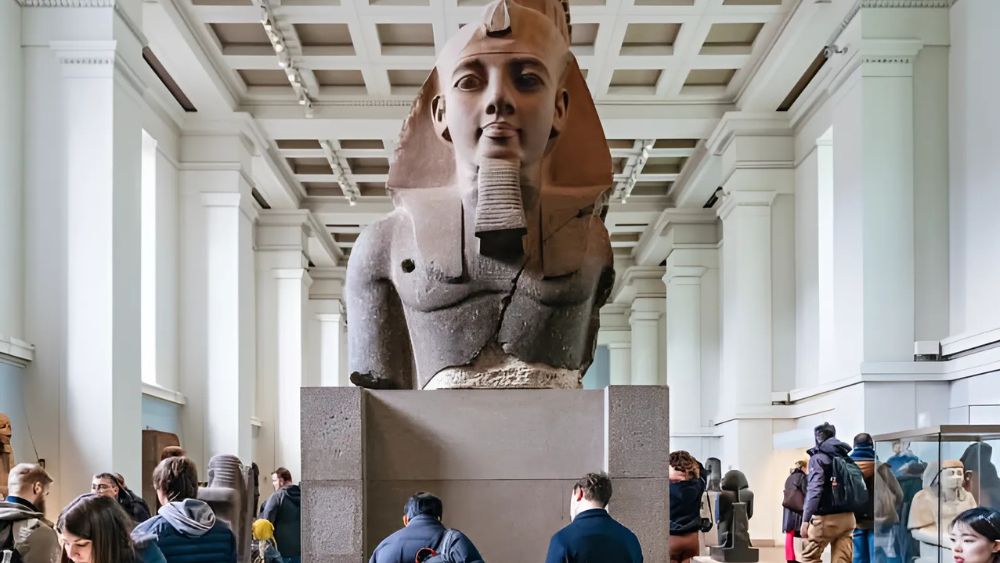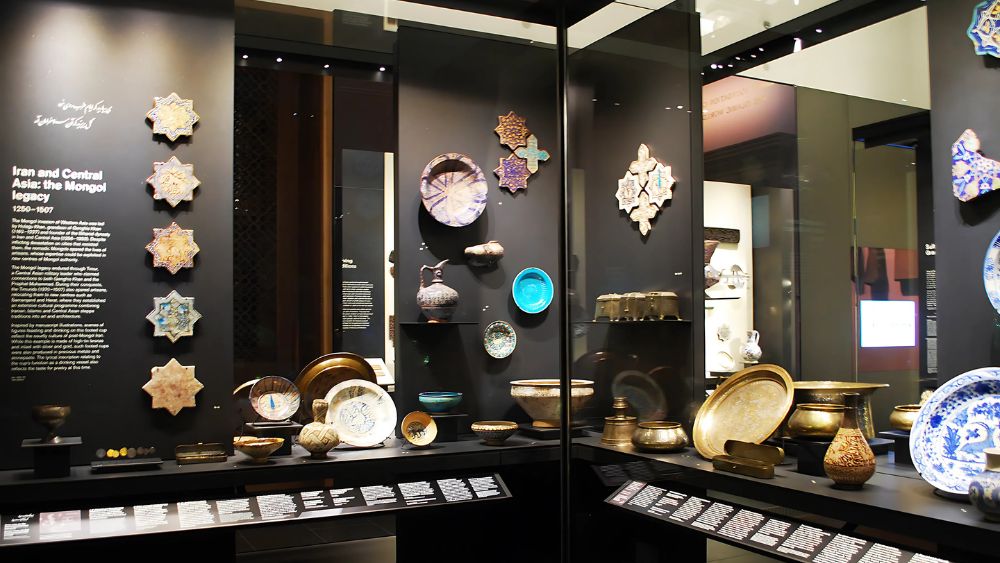Table of Contents
The British Museum: Rule and Public Access for Tourist
Learn the British Museum history, top exhibits, and visitor tips. Plan your trip to see world-famous artifacts in London’s iconic museum.
Introduction
The British Museum, located in London, is one of the world’s most renowned cultural institutions, boasting a vast collection that spans over two million years of human history. Established in 1753, it houses artifacts from ancient civilizations, including the Rosetta Stone, the Elgin Marbles, and Egyptian mummies. With free admission, the museum offers visitors an unparalleled opportunity to explore global heritage through art, archaeology, and cultural artifacts. Whether you’re a history enthusiast or a casual visitor, this guide will help you make the most of your visit.
History of The British Museum

Foundation and Early Years (1753–1800)
The British Museum was founded in 1753 by an Act of Parliament, making it the first national public museum in the world. It was established based on the collection of Sir Hans Sloane, a physician and collector who bequeathed his extensive assortment of books, manuscripts, and artifacts to the British government. The museum officially opened to the public on January 15, 1759, in Montagu House, Bloomsbury, the site where the current museum now stands.
Expansion and Acquisitions (19th Century)
During the 19th century, the British Museum grew rapidly due to acquisitions from archaeological excavations and diplomatic exchanges. Major collections added during this period include:
- The Rosetta Stone (1802) – Key to deciphering Egyptian hieroglyphs.
- The Elgin Marbles (1816) – Sculptures from the Parthenon in Athens.
- Egyptian Mummies and Artefacts – Resulting from British expeditions to Egypt.
- Assyrian Relics (1840s–1850s) – Collected from excavations in modern-day Iraq.
As the collection expanded, the museum moved beyond natural history and manuscripts, leading to the establishment of the Natural History Museum as a separate entity in 1881.
20th Century: Growth and Challenges
The museum continued to grow throughout the 20th century, adding more galleries and collections. However, World War II bombings (1940–1941) caused significant damage, leading to post-war reconstruction. The museum also faced growing debates over the repatriation of artifacts, particularly the Elgin Marbles and Benin Bronzes.
Modern Developments (21st Century)
The Great Court, a vast glass-roofed atrium designed by architect Sir Norman Foster, was opened in 2000, transforming the visitor experience. Digitalization efforts have also made millions of objects accessible online. Today, the British Museum remains a leading institution for research, education, and public engagement, drawing millions of visitors annually.
Design and Visibility of The British Museum

Architectural Design
The British Museum’s architectural design reflects its significance as a cultural and historical landmark. The museum’s main building, designed by Sir Robert Smirke in the Greek Revival style, was constructed between 1823 and 1852. Key design features include:
- Grand Façade: The museum’s main entrance on Great Russell Street features a classical Greek portico with 44 Ionic columns, inspired by ancient Greek temples.
- The Reading Room: Completed in 1857, the circular Reading Room with its grand dome was once a major research hub, used by famous figures like Karl Marx and Mahatma Gandhi.
- The Great Court: Designed by Sir Norman Foster and opened in 2000, the Queen Elizabeth II Great Court is a stunning glass-roofed courtyard that encloses the Reading Room, creating the largest covered public square in Europe.
Visibility and Landmark Status
- Prime Location: Situated in Bloomsbury, central London, the museum is easily accessible and highly visible to tourists.
- Iconic Status: The museum’s grand entrance and massive collection make it one of the most recognized and visited museums globally.
- Night Illumination: At night, the building’s lighting enhances its grandeur, making it an architectural highlight of London.
- Digital and Media Presence: The British Museum’s online collections, virtual tours, and social media engagement further enhance its global visibility.
Tips for Visitors to the British Museum
1. Plan Your Visit
- Opening Hours: The museum is open daily from 10:00 AM to 5:00 PM, with extended hours on Fridays until 8:30 PM.
- Free Entry: Admission is free, but some special exhibitions may require tickets.
- Best Time to Visit: Arrive early in the morning or late in the afternoon to avoid crowds, especially on weekends.
2. Must-See Highlights
- Rosetta Stone (Room 4) – The key to deciphering Egyptian hieroglyphs.
- Elgin Marbles (Room 18) – Sculptures from the Parthenon in Athens.
- Egyptian Mummies (Rooms 62 & 63) – A fascinating collection of ancient burial artifacts.
- Lewis Chessmen (Room 40) – Medieval chess pieces carved from walrus ivory.
- Assyrian Lion Hunt Reliefs (Room 10) – Ancient carvings from Nineveh.
3. Navigating the Museum
- Get a Map: The museum is vast, so grab a free map at the entrance or download the official app.
- Guided Tours: Consider joining a 60-minute highlights tour or an audio guide for deeper insights.
- Accessibility: The museum is wheelchair-friendly, with lifts and accessible restrooms.
4. Food & Refreshments
- Cafés: The Great Court Café and the Museum’s main restaurant offer meals and snacks.
- Picnic Areas: You can bring your own food and enjoy it in designated areas outside the museum.
5. Souvenirs & Shopping
- The British Museum Shop sells books, replicas, and unique cultural gifts related to its collections.
6. Photography & Rules
- Photography is allowed, but no flash or tripods.
- Large bags and suitcases are not permitted, so use the cloakroom if needed.
Nearby Attractions & Dining Options

Nearby Attractions (All within walking distance)
- The Cartoon Museum (5-minute walk)
- A fun collection of British cartoons and comics.
- Covent Garden (15-minute walk)
- A lively area with street performers, markets, and boutique shops.
- Soho & Chinatown (15-minute walk)
- Perfect for exploring London’s vibrant nightlife and international cuisine.
- The National Gallery (20-minute walk)
- Home to masterpieces by Van Gogh, da Vinci, and Rembrandt.
- The Charles Dickens Museum (15-minute walk)
- The former home of the famous author, filled with Victorian-era artifacts.
Best Dining Options Nearby
Casual & Quick Bites:
- Bloomsbury Coffee House (5-minute walk) – Great for breakfast, coffee, and sandwiches.
- Neptune (7-minute walk) – A stylish seafood restaurant with fresh oysters and fish.
- Franco Manca (10-minute walk) – Delicious sourdough pizza at affordable prices.
British & International Cuisine:
- The Great Court Restaurant (Inside the museum) – Elegant afternoon tea and classic British dishes.
- Hakkasan Hanway Place (10-minute walk) – Michelin-starred Chinese cuisine.
- Dishoom Covent Garden (15-minute walk) – Famous for its Bombay-style Indian food.
Pubs & Traditional British Food:
- The Plough (5-minute walk) – A historic pub with classic fish & chips.
- The Lamb (10-minute walk) – Victorian-era pub with great beer and pies.
Rules & Public Access at The British Museum
Rules for Visitors
- Free Admission – Entry to the main museum is free, but some special exhibitions require tickets.
- Opening Hours – Open daily from 10:00 AM to 5:00 PM (Fridays until 8:30 PM). Closed on December 24–26 & January 1.
- Bag Restrictions – Large bags and suitcases are not allowed inside. Small bags may be checked at the cloakroom (fees apply).
- Photography – Allowed without flash, but no tripods or selfie sticks. Filming requires special permission.
- No Food or Drinks in Galleries – Only allowed in designated café areas.
- Touching Artifacts – Strictly prohibited (unless in designated interactive zones).
- Mobile Phones – Keep on silent mode in galleries and the Reading Room.
- Guided Tours – Available for individuals and groups (some may require booking in advance).
- Children & Families – Kids must be supervised at all times. Family-friendly activities and trails are available.
- Wheelchair Access – The museum is fully accessible, with lifts, ramps, and loanable wheelchairs.
Public Access & Facilities
- Main Entrance: Great Russell Street (step-free access available).
- Alternative Entrance: Montague Place (for groups and those needing step-free access).
- Facilities:
- Free toilets and baby-changing areas
- Cloakroom for small bags
- Wi-Fi available throughout the museum
- Information desks for maps and assistance
Conclusion
The British Museum is one of the world’s most iconic cultural institutions, offering visitors a journey through over two million years of human history. From its rich history, dating back to 1753, to its stunning architecture and unparalleled collections, the museum is a must-visit destination in London.
With free public access, highlights like the Rosetta Stone, Elgin Marbles, and Egyptian mummies, and modern amenities such as the Great Court, the museum caters to history enthusiasts, researchers, and casual visitors alike. Nearby attractions, diverse dining options, and a well-organized visitor experience make it a convenient and rewarding place to explore.
Whether you’re visiting for an hour or an entire day, the British Museum offers an unforgettable experience, bringing the past to life through its extraordinary collections. Plan your visit, follow the guidelines, and immerse yourself in the wonders of human civilisation.
FAQs About The British Museum
What is The British Museum?
The British Museum is one of the world’s largest and most famous museums, dedicated to human history, art, and culture. It is located in London, England.
Where is The British Museum located?
The museum is in Great Russell Street, London, WC1B 3DG, United Kingdom.
When was The British Museum founded?
It was founded in 1753 and opened to the public in 1759.
Who founded The British Museum?
The museum was established based on the collections of Sir Hans Sloane, a physician and collector.
Is entry to The British Museum free?
Yes, general admission is free, though some special exhibitions may require a ticket.
What are the opening hours?
The British Museum is usually open daily from 10:00 AM to 5:00 PM, with extended hours on Fridays.
What is the best time to visit The British Museum?
Weekday mornings or late afternoons are the best times to avoid crowds.
Is The British Museum wheelchair accessible?
Yes, the museum is fully accessible for visitors with mobility needs.
Are guided tours available?
Yes, the museum offers guided tours, audio guides, and special talks.
Are there restaurants or cafes inside the museum?
Yes, there are several dining options, including The Great Court Restaurant and cafés.
What is The British Museum famous for?
It is renowned for housing millions of artifacts, including the Rosetta Stone, the Parthenon Marbles, and Egyptian mummies.
How many artifacts are in The British Museum?
The museum holds over 8 million objects, but only a fraction is on display.
What are the must-see exhibits at The British Museum?
The Rosetta Stone, the Parthenon Marbles, Egyptian Mummies, the Sutton Hoo treasure, and the Lewis Chessmen.
Which civilizations are represented in the museum?
The museum covers Ancient Egypt, Greece, Rome, Mesopotamia, Asia, Africa, the Americas, and European history.
Does The British Museum return artifacts to their countries of origin?
The museum has faced debates over repatriation, especially regarding the Parthenon Marbles (Greece) and the Benin Bronzes (Nigeria). Some items have been loaned or returned, but policies remain controversial.
Does The British Museum host temporary exhibitions?
Yes, the museum regularly hosts special exhibitions on different historical and cultural themes.
Can you take photos inside The British Museum?
Yes, photography is allowed in most areas, but flash and tripods are prohibited. Some special exhibitions may have restrictions.
Does The British Museum have an online collection?
Yes, a large portion of its collection is available online through the British Museum’s website.
How can I support The British Museum?
Visitors can donate, become a member, or shop at the museum store to support its work.
Does The British Museum have a gift shop?
Yes, there are multiple gift shops selling books, souvenirs, and replicas of famous artifacts.
By roamworld
Disclaimer: Travel details such as ticket prices, opening hours, and accommodation rates may change. Please check official websites or contact service providers for the latest updates.
